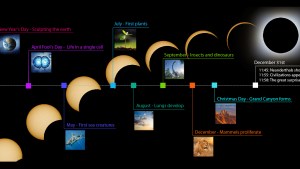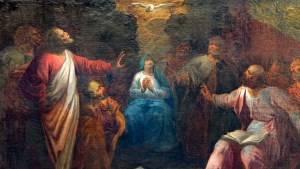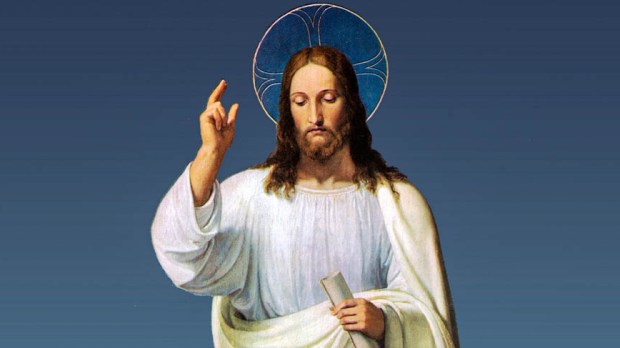No sooner have the disciples regained their Lord in the resurrection than he is gone again. “And as they were looking on,” writes Luke, Jesus “was lifted up, and a cloud took him out of their sight” (Acts 1:9). And yet, their reaction is one of rejoicing! “And they returned to Jerusalem with great joy, and were continually in the Temple blessing God” (Lk 24:52-53).
Were the Ascension merely a departure, we might wonder how much the disciples really cared for Jesus. The imagery of the scene suggests, however, that something different than a farewell is underway. By his rising in a cloud, Christ reveals himself in this moment as the one spoken of in the prophecy of Daniel: “I saw in the night visions, and behold, with the clouds of heaven there came one like a son of man, and he came to the Ancient of Days and was presented before him. And to him was given dominion and glory and kingdom, that all peoples, nations, and languages should serve him; his dominion is an everlasting dominion, which shall not pass away, and his kingdom one that shall not be destroyed” (Dan 7:13-14). Put simply, the Ascension signals Christ’s enthronement as king. That’s certainly cause for rejoicing.
This, though, is not the end of the story. Christ’s Ascension in the Acts of the Apostles is preceded by the disciples’ question, “Lord, will you at this time restore the kingdom to Israel?” (Acts 1:6) and by Christ’s assurance that the disciples will “be my witness” (Acts 1:8), precisely so as to spread the kingdom. The enthronement of Christ in the Ascension relates directly to this task. What “Jesus began to do before he was taken up” (Acts 1:1) will now, through his Ascension and the gift of his Sprit at Pentecost (Acts 1:8; 2:1ff.), be carried through in the disciples as they witness to Jesus “in Jerusalem and in all Judea and Samaria and to the end of the earth” (Acts 1:8).
It is important to see that what takes place here is not the handing on of a mission that once belonged to Christ but does so no longer. It is rather the drawing of the disciples into the ongoing mission of Christ by drawing them into his body (1 Cor 12:27). St. Luke relates that “in the first book,” the Gospel of Luke, he “dealt with all that Jesus began to do and teach” (Acts 1:1). In Acts, his second book, St. Luke narrates what Jesus does now in and through the Church—and this after his Ascension. We can, then, understand the Ascension not as a going away but as a departure which opens to the world a more intimate form of union. And certainly, that too is cause for rejoicing!
What’s more, the Ascension announces emphatically just what such a union brings about. If in earlier resurrection appearances Jesus cleanly vanishes from sight (e.g. Lk 24:31), in the Ascension he remains present in all of his bodiliness. He is not taken up from his body, but in it, and so union with Christ enfolds both his humanity and our own. “We are,” and Oliver Davies wrote, “free within materiality and not beyond it.”
It is here that the Ascension most strains our imagination, for we fail in trying to conceive of “the irreversible entry of his humanity [and so his body!] into divine glory” (§659). The Ascension is no literary fiction, and yet if we conceive of this event with an understanding of the body as we experience it now, Jesus’ departure becomes unintelligible. We are left to imagine him careening continually skyward. Thinking that is just what the New Testament meant to say, Carl Sagan once joked (disparagingly) that Jesus, even were he traveling at the speed of light, would only just now be reaching the edge of the Milky Way. This, of course, is not what Scripture means to convey. It insists both that Jesus dos not leave his humanity behind and that what his humanity becomes in this moment defies imagining. “What we will be has not yet been revealed” (1 John 3:2).

Read more:
A Christian reflection on the eclipse: Timing is everything
In speaking of the Resurrection, the Catechism teaches that Christ’s rising from the dead leaves, as it were, a footprint in history. It “could be verified by the sign of the empty tomb and by the reality of the apostles’ encounters with the risen Christ.” Even so, the resurrection remains “as something that transcends and surpasses history” (§647). Jesus enters “life beyond time and space” (§646), and while for a period “his glory remains veiled under the appearance of ordinary humanity” (§659) as he eats and drink with his disciples, it remains so no longer in the Ascension. “Jesus’ final apparition ends with the irreversible entry of his humanity into divine glory” (§659). In this way the Ascension reveals both the permanence of the Son’s union with his humanity and so also the whole of what that humanity stands open to become. It announces the reality towards which the Church in her humanity is drawn and which—as seen in the Assumption of the Blessed Virgin—it already becomes. And certainly, that too is cause for rejoicing!

Read more:
Pentecost is a celebration of possibilities

